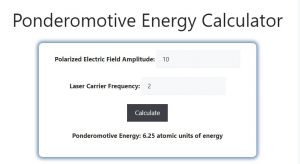About Ponderomotive Energy Calculator (Formula)
Ponderomotive energy is an important concept in physics, particularly in the field of plasma physics and nonlinear optics. It refers to the energy that charged particles acquire when subjected to time-varying electromagnetic fields. The Ponderomotive Energy Calculator allows researchers and engineers to quantify this energy, which is crucial for understanding phenomena in lasers, particle accelerators, and other advanced technologies. By calculating ponderomotive energy, you can gain insights into how electric fields influence charged particles in various applications.
Formula
The formula for calculating ponderomotive energy is: Up = Ea^2 / (4 * w^2), where Up represents the ponderomotive energy, Ea is the amplitude of the electric field, and w is the angular frequency of the field.
How to Use
Using the Ponderomotive Energy Calculator is straightforward. First, gather the necessary values: the amplitude of the electric field (Ea) and the angular frequency (w) of the electromagnetic field. Input these values into the calculator to compute the ponderomotive energy (Up). This calculation is essential for researchers and engineers working with charged particles and electromagnetic fields.
Example
Let’s consider a scenario where the amplitude of the electric field (Ea) is 10^3 V/m, and the angular frequency (w) is 2 x 10^9 rad/s. To calculate the ponderomotive energy:
- Plug the values into the formula:
- Up = (10^3)^2 / (4 * (2 x 10^9)^2).
- Calculate the numerator:
- Up = 10^6.
- Calculate the denominator:
- 4 * (4 x 10^18) = 16 x 10^18.
- Now divide:
- Up = 10^6 / 16 x 10^18 = 6.25 x 10^-13 J.
This result indicates that the ponderomotive energy is approximately 6.25 x 10^-13 joules.

FAQs
- What is ponderomotive energy?
Ponderomotive energy is the energy acquired by charged particles in an oscillating electromagnetic field. - Why is ponderomotive energy important?
It helps in understanding the behavior of charged particles in laser-plasma interactions and other electromagnetic applications. - What do the variables in the formula represent?
Ea is the amplitude of the electric field, and w is the angular frequency of the electromagnetic field. - How is angular frequency defined?
Angular frequency is the rate of rotation in radians per second, calculated as w = 2πf, where f is the frequency in hertz. - Can ponderomotive energy affect particle acceleration?
Yes, ponderomotive energy can contribute to the acceleration of charged particles in varying electromagnetic fields. - What units are used in the ponderomotive energy formula?
Ponderomotive energy is expressed in joules (J), while electric field amplitude is in volts per meter (V/m) and angular frequency in radians per second (rad/s). - How does ponderomotive energy relate to laser physics?
In laser applications, ponderomotive energy can help explain the dynamics of charged particles in the presence of strong electric fields. - Is there a limit to the ponderomotive energy that can be achieved?
Yes, practical limits depend on the strength of the electric field and the properties of the charged particles involved. - How can I experimentally measure ponderomotive energy?
Experimental measurements typically involve analyzing particle trajectories in controlled electromagnetic fields and calculating the energy based on observed behavior. - Can ponderomotive energy calculations help in designing particle accelerators?
Yes, understanding ponderomotive energy is crucial for optimizing the design and operation of particle accelerators. - How does the amplitude of the electric field affect ponderomotive energy?
Higher amplitudes result in greater ponderomotive energy, leading to more significant effects on charged particles. - What happens if the angular frequency is very high?
Very high angular frequencies can lead to diminished ponderomotive effects due to reduced interaction time between the particles and the field. - Can ponderomotive energy be negative?
No, ponderomotive energy is always a positive value since it is based on the square of the electric field amplitude. - How does ponderomotive energy relate to non-linear optics?
Ponderomotive effects play a significant role in the interaction of light with matter in non-linear optical materials. - Are there practical applications for calculating ponderomotive energy?
Yes, applications include laser processing, laser-induced particle acceleration, and improving the efficiency of electromagnetic devices. - What factors can influence the effectiveness of ponderomotive energy?
Factors include the characteristics of the electric field, the properties of the medium through which the charged particles are moving, and the initial conditions of the particles. - How can simulations assist in understanding ponderomotive energy?
Simulations can model complex interactions between charged particles and electromagnetic fields, providing insights that can be difficult to achieve experimentally. - Is ponderomotive energy relevant to astrophysics?
Yes, ponderomotive effects are considered in various astrophysical contexts, such as understanding cosmic ray behavior in magnetic fields. - How can I apply the results of the ponderomotive energy calculation?
Results can inform design choices in electromagnetic applications, enhance safety protocols, or improve efficiency in particle manipulation technologies. - What advancements are being made in the study of ponderomotive energy?
Research continues to evolve with advancements in laser technology and particle physics, focusing on enhancing our understanding of nonlinear dynamics in electromagnetic fields.
Conclusion
The Ponderomotive Energy Calculator is a vital tool for anyone involved in the study or application of electromagnetic fields and charged particles. By understanding and calculating ponderomotive energy, researchers and engineers can gain crucial insights into the behavior of particles under varying electric fields. This knowledge is not only fundamental to plasma physics but also has significant implications for a wide range of technologies, from laser systems to particle accelerators. Regularly utilizing this calculator will enable better analysis, optimization, and advancement in related scientific and engineering fields.